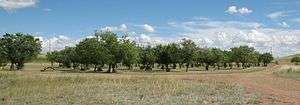Special Area No. 2
| Special Area No. 2 | |
|---|---|
| Special area | |
|
| |
| Nickname(s): Special Area 2 | |
 Location of Special Area No. 2 in Alberta | |
| Coordinates: 51°24′N 111°42′W / 51.4°N 111.7°WCoordinates: 51°24′N 111°42′W / 51.4°N 111.7°W | |
| Country |
|
| Province |
|
| Region | Southern Alberta |
| Census division | No. 4 |
| Incorporated | April 7, 1959[1] |
| Government | |
| • Governing body | Special Areas Board |
| • Municipal office | Hanna |
| • District office | Hanna |
| Area (2016)[2] | |
| • Land | 9,347.57 km2 (3,609.12 sq mi) |
| Population (2016)[2] | |
| • Total | 1,905 |
| • Density | 0.2/km2 (0.5/sq mi) |
| Time zone | MST (UTC-7) |
| • Summer (DST) | MDT (UTC-6) |
| Postal Code Prefix | T0J |
| Area code | +1-403 |
| Website | Special Areas Board |
Special Area No. 2 is a special area in southern Alberta, Canada. It is a rural municipality similar to a municipal district, however, the elected council is overseen by three representatives appointed by the province, the Special Areas Board.
Special Area 2 has two provincial parks, Little Fish Lake Provincial Park, and the portion of Dinosaur Provincial Park north of the Red Deer River. Lakes include Little Fish Lake, Dowling Lake, and the south portion of Sullivan Lake.
Demographics
In the 2016 Census of Population conducted by Statistics Canada, Special Area No. 2 recorded a population of 1,905 living in 648 of its 750 total private dwellings, a change of −5.9% from its 2011 population of 2,025. With a land area of 9,347.57 km2 (3,609.12 sq mi), it had a population density of 0.2/km2 (0.5/sq mi) in 2016.[2]
In the 2011 Census, Special Area No. 2 had a population of 2,025 living in 698 of its 745 total dwellings, a change of -2.4% from its 2006 population of 2,074. With a land area of 9,342.42 km2 (3,607.13 sq mi), it had a population density of 0.2/km2 (0.6/sq mi) in 2011.[3]
Communities and localities
|
The following urban municipalities are surrounded by Special Area No. 2:[4]
The following hamlets are located within Special Area No. 2:[4] |
The following localities are located within Special Area No. 2:[5]
|
|
References
- ↑ "Municipal Profile: Special Areas Board" (PDF) (PDF). Alberta Municipal Affairs. October 24, 2014. p. 1. Retrieved November 3, 2014.
- 1 2 3 "Population and dwelling counts, for Canada, provinces and territories, and census subdivisions (municipalities), 2016 and 2011 censuses – 100% data (Alberta)". Statistics Canada. February 8, 2017. Retrieved February 8, 2017.
- ↑ "Population and dwelling counts, for Canada, provinces and territories, and census subdivisions (municipalities), 2011 and 2006 censuses (Alberta)". Statistics Canada. 2012-02-08. Retrieved 2012-02-08.
- 1 2 "Specialized and Rural Municipalities and Their Communities" (PDF). Alberta Municipal Affairs. 2012-03-01. Retrieved 2012-08-12.
- ↑ "Standard Geographical Classification (SGC) 2006, Economic Regions: 4804004 - Special Area No. 2, geographical codes and localities, 2006". Statistics Canada. 2010-03-05. Retrieved 2012-08-12.

